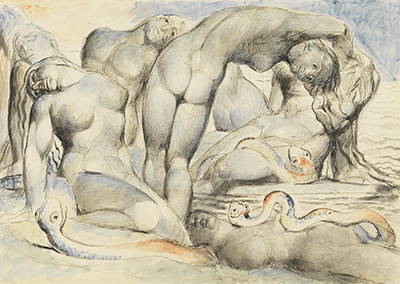The Punishment of the Thieves is a known painting created by William Blake. It is not exactly clear when it was painted, but sources show that it is probably between 1824 and 1827 before his death. The painting is part of the Illustrations to Dante's Divine Comedy.
The painting is on chalk, ink, and watercolour on a paper medium. Its dimensions are 372 × 527 mm for the support and 598 × 740 × 20 mm for the frame. It is within the Tate collection, among other William Blake paintings. The acquisition involves multiple parties. It was purchased with a special grant from the National Gallery in Washington D.C, where it is currently located. Donations from Lord Duveen, Art Fund, were part of the acquisition, and so it was presented through the Art Fund in 1919. Its reference number is N03364.
The painting is unique with a thoughtful theme that seems straightforward, but there are many ways to look at it. The image shows female figures that are pretty masculine. This shows some form of gender ambiguity that is not as common to see in many paintings. It could imply some form of moral degeneracy for people living in the 19th century. It shows a central body contracted more than average giving, which is merely a form of mockery or parody compared to contrapposto of classical statues. Other figures that seem to be truncated and cropped show some form of licentious signature.
Just from the name, the characters are probably thieves, and snakes are biting them. Some of them seem dead, while some of them seem to be alive but struggling to stay alive. The snakes probably represent some form of treachery and cunningness. With some of the snakes that seem to be coming out of the character's lower regions, it may be a suggestion that the criminal activities of the thieves are giving rise to a form of aberration.
The colors of the painting are rather pale, with hues of blue and orange. Shades of grey and whites appear more in the central part of the painting. William Blake's style comes from diverse influenced from other artists like John Liddell. Through the painting, it is possible to determine the religious influences and backgrounds he comes from. The punishment seems to be religious at some level, representing a serpent as the root of all evil and connected directly with the thieves. The more you look at the painting, the more you can see the representation.




